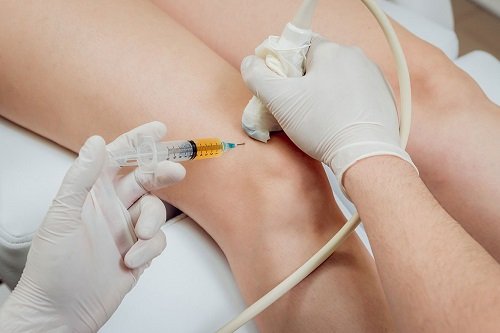PRP Intiltration for Wound Management
PRP infiltration, also known as Platelet-Rich Plasma infiltration, is a medical procedure that involves the injection of Platelet-Rich Plasma (PRP) into a specific area of the body, typically a joint, muscle, or tissue. PRP is a component of a patient’s own blood that is enriched with a higher concentration of platelets, growth factors, and bioactive proteins than normal blood. These components have regenerative and healing properties, making PRP infiltration a popular treatment for various medical conditions and injuries.
PRP is a component of a patient’s own blood that is rich in platelets, growth factors, and other bioactive proteins. These platelets play a crucial role in the body’s natural healing process.

Symptoms of PRP Infiltration:
Symptoms of PRP infiltration can vary depending on the specific procedure and the location of the infiltration. Common symptoms may include:
Pain: Patients may experience localized pain or discomfort at the site of PRP infiltration.
Swelling: Swelling, redness, or inflammation can occur around the area where the PRP has leaked.
Bruising: In some cases, bruising may develop due to blood vessel damage during the infiltration.
Numbness or Tingling: Patients may report numbness or tingling sensations in the affected area.
Skin Changes: Skin may appear discolored or exhibit changes in texture due to the infiltration.
Infection: While rare, there is a risk of infection if bacteria enter the site of PRP infiltration.
Causes of PRP Infiltration:
Inadequate Technique: Inexperienced or improperly trained medical professionals may inadvertently cause PRP infiltration by not accurately targeting the injection site.
Needle Misplacement: A misplaced or improperly inserted needle during the PRP injection can lead to infiltration. This can happen if the needle goes through the targeted tissue or if it exits the tissue on the other side.
Excessive Injection Pressure: Injecting PRP too forcefully can result in the solution spreading beyond the intended area.
Anatomical Variations: Variations in a patient’s anatomy, such as unusually thin or fragile tissues, may increase the risk of PRP infiltration.
Bleeding Disorders: Patients with bleeding disorders or those taking blood-thinning medications may be at a higher risk of bleeding and infiltration.
Lack of Visualization: Some procedures may be performed without real-time imaging guidance (such as ultrasound), making it more challenging to precisely place the PRP.
Applications of PRP Infiltration:
Musculoskeletal Injuries: PRP infiltration is frequently used to treat musculoskeletal injuries, including tendon and ligament injuries, muscle strains, and joint pain. It can be applied to various areas of the body, such as the knee, shoulder, and Achilles tendon.
Orthopedic Conditions: PRP infiltration is employed in orthopedics to accelerate the healing of fractures, reduce pain in degenerative joint conditions like osteoarthritis, and enhance recovery after orthopedic surgeries.
Dermatological Procedures: PRP infiltration is used in aesthetic and dermatological treatments, including facial rejuvenation and hair restoration. It can stimulate collagen production, improve skin texture, and promote hair growth.
Chronic Pain Management: PRP infiltration is used to manage chronic pain conditions, such as plantar fasciitis and chronic lower back pain. It offers a non-surgical option for pain relief.
Benefits of PRP Infiltration:
Natural Healing: PRP utilizes the body’s natural healing mechanisms, promoting tissue repair and regeneration.
Minimally Invasive: PRP infiltration is a minimally invasive procedure that typically requires only local anesthesia, reducing the risks associated with surgery.
Reduced Pain: Many patients experience a reduction in pain and inflammation after PRP treatment, often leading to improved quality of life.
Faster Recovery: PRP can accelerate the healing process, allowing individuals to return to their normal activities more quickly.
Customized Treatment: PRP infiltration can be tailored to the patient’s specific needs and conditions, ensuring a personalized treatment plan.
Prevention and Management:
To prevent PRP infiltration, healthcare providers should use proper techniques, have the necessary training, and consider the patient’s medical history. In cases where PRP infiltration occurs, prompt assessment and management are crucial to minimize potential complications. Treatment may include:
- Applying pressure to the affected area to limit further leakage.
- Administering appropriate medications to alleviate pain and inflammation.
- Monitoring for signs of infection.
- In severe cases, aspiration (removal) of the infiltrated PRP may be necessary.
- Revision procedures may be required to address any adverse effects or unsatisfactory outcomes caused by the infiltration.
